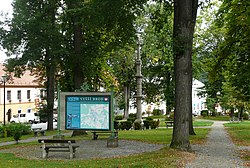Vyšší Brod
Vyšší Brod | |
|---|---|
 Town square | |
| Coordinates: 48°36′58″N 14°18′43″E / 48.61611°N 14.31194°E | |
| Country | |
| Region | South Bohemian |
| District | Český Krumlov |
| First mentioned | 1259 |
| Government | |
| • Mayor | Jindřich Hanzlíček |
| Area | |
• Total | 69.75 km2 (26.93 sq mi) |
| Elevation | 571 m (1,873 ft) |
| Population (2024-01-01)[1] | |
• Total | 2,564 |
| • Density | 37/km2 (95/sq mi) |
| Time zone | UTC+1 (CET) |
| • Summer (DST) | UTC+2 (CEST) |
| Postal code | 382 73 |
| Website | www |
Vyšší Brod (Czech pronunciation: [ˈvɪʃiː ˈbrot]; German: Hohenfurth) is a town in Český Krumlov District in the South Bohemian Region of the Czech Republic. It has about 2,600 inhabitants. It is the southernmost municipality in the Czech Republic. Vyšší Brod Monastery, an important historical monument, is located in the town. The historic town centre with the monastery complex is well preserved and is protected by law as an urban monument zone.
Administrative parts
[edit]The villages of Dolní Drkolná, Dolní Jílovice, Herbertov, Hrudkov, Lachovice, Studánky and Těchoraz are administrative parts of Vyšší Brod.
Etymology
[edit]The name literally means 'higher ford'.
Geography
[edit]Vyšší Brod is located about 21 kilometres (13 mi) south of Český Krumlov and 40 km (25 mi) south of České Budějovice. About two thirds of the municipal territory lie in the Bohemian Forest Foothills, only the western part lies in the Bohemian Forest. The highest point is the mountain Jezevčí vrch at 984 m (3,228 ft) above sea level. The municipal territory borders Austria in the south; the Vyšší Brod Pass is located on the border.
The Vltava River flows through the town. The streams Menší Vltavice and Větší Vltavice flow into the Vltava in Vyšší Brod. The Lipno II Reservoir, built on the Vltava, is located on the northern outskirts of the town.
History
[edit]
Vyšší Brod was founded on an old trade route near a ford (Czech: brod) across the Vltava, hence the name. The first written mention of the settlement is in the deed of foundation of the Cistercian monastery from 1259, where Vok I of Rosenberg confirmed the donation of a large area for the benefit of this monastery and mentioned the market settlement of Vyšší Brod and the church. The settlement was probably founded much earlier.[2]
In 1870, Vyšší Brod was promoted to a town by Emperor Franz Joseph I. After 1918, the coexistence of the German-speaking majority and the Czech minority stabilized. After World War II, most of the ethnic German population was expelled and was resettled by mostly non-native population. The Iron Curtain was established and the monastery was forcibly abolished.[2]
After the opening of borders in 1989, the town's importance strongly grew due to the direct road to the border crossing at Studánky / Weigetschlag.[2] In 1990, the monks returned to the monastery.[3]
Demographics
[edit]
|
|
| ||||||||||||||||||||||||||||||||||||||||||||||||||||||
| Source: Censuses[4][5] | ||||||||||||||||||||||||||||||||||||||||||||||||||||||||
Transport
[edit]Vyšší Brod lies on the railway line of local importance from Rybník to Lipno nad Vltavou.
The road border crossing Studánky / Weigetschlag is located at the Vyšší Brod Pass in the municipal territory.
Sights
[edit]

The Cistercian Vyšší Brod Monastery with the Church of the Assumption of the Virgin Mary is the most important building and the main landmark of the town. For its value, it is protected as national cultural monument.[6] The monastery complex also houses a postal museum, a branch of the Prague Postal Museum.
The Church of Saint Bartholomew is located on the town square. It was originally an early Gothic building, documented already in 1259, when the monastery was founded. The oldest preserved part of the church is the chancel, which dates from the second half of the 13th century. Modifications were made in the 16th and 17th centuries. In 1715, the church was extended. In the second half of the 19th century, the tower was restored to its Gothic appearance.[7]
The second landmark of the town square is the Old Town Hall. It was originally a house from 1524, which was rebuilt into the town hall after the 1569 fire. Its present neo-Gothic form is a result of the reconstruction from 1883. Until 1947, the building served as a town hall. Today it houses the tourist infocentre.[8]
In Loučovice is a Marian pilgrimage site called Maria Rast. The pilgrimage tradition began there in 1844. The complex of the pseudo-Gothic buildings with the Chapel of Maria Rast was built in 1888–1890. The way to the chapel is lined by the Stations of the Cross dating from 1898.[9]
Notable people
[edit]- Leopold Wackarž (1810–1901), Cistercian abbot general, died here
- Franz Isidor Proschko (1816–1891), Austrian writer
Honours
[edit]The asteroid no. 121089, which was discovered in 1999 by Miloš Tichý from the Kleť Observatory, was named after the town.
References
[edit]- ^ "Population of Municipalities – 1 January 2024". Czech Statistical Office. 2024-05-17.
- ^ a b c "Stručná historie města" (in Czech). Město Vyšší Brod. Retrieved 2021-09-04.
- ^ "Obnova klášterního života po pádu komunismu r. 1989" (in Czech). Vyšší Brod Monastery. Retrieved 2021-09-04.
- ^ "Historický lexikon obcí České republiky 1869–2011" (in Czech). Czech Statistical Office. 2015-12-21.
- ^ "Population Census 2021: Population by sex". Public Database. Czech Statistical Office. 2021-03-27.
- ^ "Klášter cisterciáků Vyšší Brod" (in Czech). National Heritage Institute. Retrieved 2024-11-13.
- ^ "Kostel sv. Bartoloměje se hřbitovem" (in Czech). National Heritage Institute. Retrieved 2024-11-13.
- ^ "Stará radnice s městským parkem" (in Czech). National Heritage Institute. Retrieved 2024-11-13.
- ^ "Poutní místo Maria Rast" (in Czech). National Heritage Institute. Retrieved 2024-11-13.



